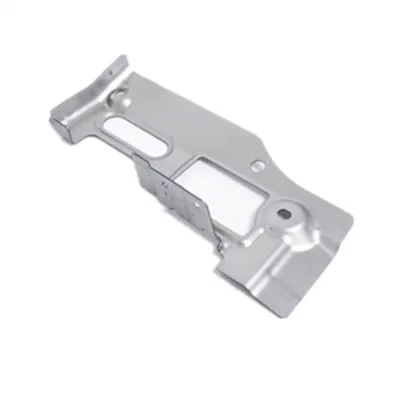- English
- Español
- Português
- русский
- Français
- 日本語
- Deutsch
- tiếng Việt
- Italiano
- Nederlands
- ภาษาไทย
- Polski
- 한국어
- Svenska
- magyar
- Malay
- বাংলা ভাষার
- Dansk
- Suomi
- हिन्दी
- Pilipino
- Türkçe
- Gaeilge
- العربية
- Indonesia
- Norsk
- تمل
- český
- ελληνικά
- український
- Javanese
- فارسی
- தமிழ்
- తెలుగు
- नेपाली
- Burmese
- български
- ລາວ
- Latine
- Қазақша
- Euskal
- Azərbaycan
- Slovenský jazyk
- Македонски
- Lietuvos
- Eesti Keel
- Română
- Slovenski
How to Maintain Quality Control in Metal Stamping
2024-10-09
Metal stamping is a manufacturing process used to shape, form, and cut metal sheets into a variety of components. It is a versatile technique utilized in industries like automotive, electronics, and aerospace. Ensuring high-quality stamped metal parts is critical for maintaining product integrity, safety, and overall efficiency in production. Therefore, implementing a robust quality control (QC) system is essential.
In this blog, we’ll explore key strategies and methods for maintaining quality control in metal stamping operations, addressing challenges, tools, and best practices to ensure high-quality outcomes.
1. Implementing a Comprehensive Quality Control Plan
The first step in ensuring quality control is to develop a comprehensive quality control plan that outlines standards, inspection protocols, and acceptance criteria for metal stamped parts. This plan should include:
- Detailed Specifications: Clearly define dimensional tolerances, material properties, and surface finish requirements for each part.
- Inspection Points: Identify critical control points in the production process where inspections should be conducted.
- Testing Methods: Specify testing methods, such as visual inspections, dimensional measurements, and surface finish analysis.
By establishing a clear QC plan, all stakeholders understand the quality expectations, which helps to reduce errors and streamline the QC process.
2. Utilizing Advanced Measuring Tools and Techniques
Accurate measurement is a cornerstone of quality control in metal stamping. Modern measurement tools and techniques can detect even the slightest deviations in parts. Some key tools include:
- Coordinate Measuring Machines (CMMs): These devices use probes to measure the dimensions of metal parts with high precision, ensuring that parts meet dimensional tolerances.
- Optical Comparators: These devices use lenses and lights to project the image of a part onto a screen for precise measurement and comparison against the original design.
- Surface Roughness Testers: These devices measure the surface texture of stamped parts to ensure they meet the desired finish and surface quality.
- Laser Scanners: Laser scanning technology captures 3D data of the part, enabling detailed inspections of complex geometries.
Using these tools, quality control inspectors can identify defects and non-conformities quickly and accurately, ensuring that only parts that meet specifications are approved.

3. Conducting Regular In-Process Inspections
In-process inspections are essential to identify defects and issues as they occur, preventing defective products from progressing through the production line. Some common in-process inspections include:
- First Article Inspection (FAI): An FAI is performed on the first item produced from a new stamping setup or after a significant change in the process. This inspection verifies that the initial part meets all specifications.
- Tool Wear Monitoring: Regularly inspect stamping tools for wear and tear, as worn tools can lead to defects such as burrs, cracks, or deformations.
- Sampling Inspections: Perform periodic sampling inspections during production to ensure that parts continue to meet quality standards. Adjust sampling frequency based on defect trends and historical performance.
In-process inspections help identify and correct issues before they affect a larger batch of parts, reducing waste and rework costs.
4. Establishing Statistical Process Control (SPC)
Statistical Process Control (SPC) involves using statistical methods to monitor and control the metal stamping process. By analyzing data from various stages of production, SPC helps identify trends, variations, and deviations from expected performance. Implementing SPC includes:
- Control Charts: Use control charts to monitor key parameters such as dimensions, surface finish, and material thickness. Control charts can signal when a process is moving out of tolerance before defects occur.
- Process Capability Analysis: Measure the process capability (Cp and Cpk values) to assess how well the process can produce parts within specifications. A higher Cp and Cpk value indicates a more capable process.
- Trend Analysis: Regularly analyze data for trends that may indicate process drift or equipment wear.
SPC allows manufacturers to maintain tight control over the stamping process and make data-driven decisions to maintain quality.
5. Implementing Preventive Maintenance Programs
Machine and tool maintenance play a significant role in ensuring consistent product quality. Regular preventive maintenance prevents unexpected downtime and reduces the risk of defective parts caused by equipment malfunctions. A preventive maintenance program should include:
- Scheduled Tool Inspections: Regularly inspect and service stamping dies, punches, and other tooling to prevent wear-related defects such as misalignment or burr formation.
- Lubrication and Cleaning: Proper lubrication and cleaning of stamping presses and dies reduce friction and wear, improving the quality of stamped parts.
- Calibration of Measuring Equipment: Regularly calibrate measuring instruments to ensure their accuracy and reliability during inspections.
Maintaining equipment in peak condition ensures that the stamping process operates smoothly and efficiently, reducing the likelihood of defects.
6. Employee Training and Skill Development
Quality control is only as effective as the personnel implementing it. Providing regular training for operators, quality inspectors, and maintenance personnel is crucial for maintaining high standards in metal stamping. Training programs should cover:
- Understanding Specifications and Standards: Ensure that all employees are familiar with part specifications, industry standards, and quality requirements.
- Inspection Techniques and Tool Use: Train employees on using inspection tools, interpreting results, and understanding how to apply inspection criteria.
- Process Control and Troubleshooting: Teach employees how to monitor process parameters, identify potential issues, and take corrective actions.
An informed and skilled workforce is better equipped to prevent quality issues and respond effectively to deviations.
7. Using Digital and Automated Inspection Systems
Automation and digital technologies are revolutionizing quality control in metal stamping. Automated inspection systems, such as vision systems and robotic measurement tools, can quickly and accurately inspect parts without human intervention. These systems offer several benefits:
- Consistency: Automated systems reduce the variability associated with human inspections, providing consistent and repeatable results.
- Speed: Automated inspections are faster, allowing for 100% inspection of parts in high-volume production.
- Data Collection and Analysis: Automated systems collect data in real-time, enabling quick analysis and identification of trends or issues.
Implementing digital and automated inspection systems can significantly enhance quality control capabilities in metal stamping operations.
8. Conducting Root Cause Analysis and Continuous Improvement
Even with stringent quality control measures in place, defects may still occur. Conducting root cause analysis (RCA) helps identify the underlying causes of defects and implement corrective actions to prevent recurrence. RCA techniques include:
- Fishbone Diagrams (Ishikawa): Identify potential causes of defects related to materials, methods, machines, and personnel.
- 5 Whys Analysis: Ask "Why?" multiple times to drill down to the root cause of a problem.
- Failure Mode and Effect Analysis (FMEA): Assess the risk and impact of potential failure modes in the process.
Incorporating continuous improvement methodologies like Lean and Six Sigma fosters a culture of ongoing quality enhancement, reducing defects and improving overall process performance.
Final Thoughts
Maintaining quality control in metal stamping is a complex task that requires a multi-faceted approach. By implementing a comprehensive QC plan, using advanced measurement tools, conducting in-process inspections, leveraging statistical process control, and investing in employee training and preventive maintenance, manufacturers can ensure that metal stamped parts consistently meet the highest quality standards. With a focus on continuous improvement and the adoption of modern technologies, metal stamping operations can achieve high precision, efficiency, and product reliability.
Dongguan Fu Cheng Xin Communication Technology Co., Ltd. is committed to the development, production, assembly, ODM one-stop service hardware suppliers. We have our own factory.If you are interested, please contact Lei.wang@dgfcd.com.cn.



